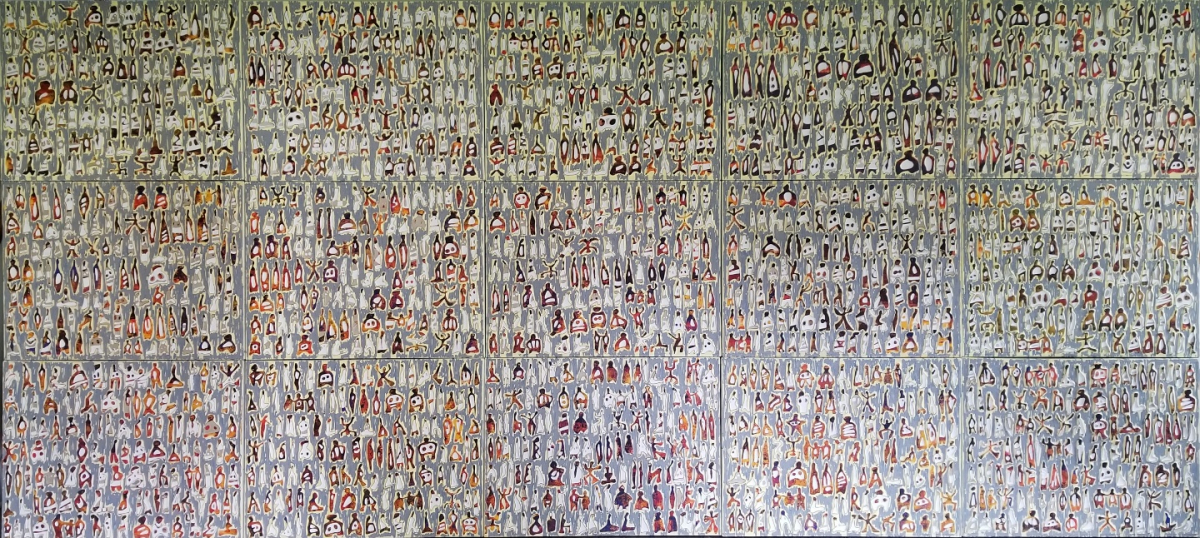
Janghan Choi
Korean Cultural Center - Tenafly, NJ
Choi's multifaceted installations employ the abstracted human form in movement as sign language thus demonstrating a relationship to collective memory and Jungian archetypes, and in their essentialized forms, to cave painting also. Human Evolution I, 2019 which a triptych of neutral background with navy and puce colored signs and a central tondo with rune-like shapes, reveals the artist's interest in pre-historic cultures. His works in general and this work in particular, can be read in terms of the four main Jungian archetypes the anima/animus representing our true self, the shadow or our negative side, the persona which is our public side, and the self that is a unified whole symbolized by a circle such as the ones in Choi's works. As Jung believed, these archetypes represent globally accepted innate forms that are part of patterns of human behavior. In addition, the psychologist found that the idea behind these ‘primordial images' or mythical/archaic archetypes were part and parcel of any human.
These types of archetypical forms are used by many well-known contemporary artists including the Israeli Michal Rovner. But, whereas Rovner works with new media as in her Tablets, 2004, Choi for the most part, works with mixed media and painting. Rovner references specific traumatic events like the Palestinian crisis, Choi looks to engage with the history of humanity in general. These cyphers act as foil for Choi to examine and deploy cultural sign as language that involves looking into the human past to find the present. Both Rovner and Choi use what appear to be letters but which are abstracted human forms in dance-like movement that leave their trace on the page as does writing or inscribing on a page. Whereas Rovner re-interprets history through new media, Choi re-discovers and pays tribute to it.

Choi's drawings can be seen as marks of communication and at the same time as cave painting and human evolution or traces of human presence. In his wall installation Human Evolution II, 2019 Choi uses a puce color background upon which are inscribed simplified human figures in shades of brown, rust and white. Because both the white and the colored figures depict human forms through linear networks much like cave paintings or Greek geometric vase paintings, there is a resultant figure ground ambiguity that takes place where we read the white as background and as figure and vice versa. This type of inscription is similar to sgraffito used on Greek pottery but also has a relationship to ancient Chinese oracle bones. These sgraffitoed bones were usually animal scapulae that were inscribed by the King in order to divine the seasonal cycle's production a practice that began in the Shang Dynasty. Oracle bones were also known as dragon bones. This practice after the Chou Dynasty was abandoned by the King but was continued by Shamans who were more often than not women. The King or Shaman would carve the questions onto the bone, apply heat with a metal rod and then read the patterns of the cracking produced by the heat. Because these markings in the early 20th century, proved to be historical characterized by writing, we can say that Choi's engagement with them segues from the pre-historic into the historical eras. Consequently, Choi traces human existence through its traces or signs.
Like the Egyptian Palette of Narmer (c.3100 BC) or the Akkadian tablet of Naram-sin (c. 2254-2218 BC) Choi's tablets are executed in relief sculpture but the latter is not about famous battle victories like the earlier. Choi's figures are not engaged in battle or proudly depicting a larger than life leader, they are evenly spaced and sized. The ancient tablets were sized hieratically whereas the King is the largest figure and everyone else was sized according to their importance in that society. Choi's evenly sized figures are concordant with the idea of democracy wherein individual figures are evenly configured. Marxist critic Linda Nochlin discusses George Seurat’s divisionism in terms of political allegories of parity and the "anti-Utopian" modern condition.

The floor installation piece Human Evolution III, 2019 because of its orientation holds similarities to Carl Andre's minimalist sculptures. Both Choi and Andre used grid formatted structures to give order to their language. They also used repetition as a way of emphasizing their linear forms and placed their sculptures on the floor. But whereas Andre emphasized the space above his works that could even be read as column, Choi focuses on the solidity attained from carving elements in relief that depict the exchange relationship between solid and void. This idea relates to the Korean concept of yin yang found in Taoism one of the religious philosophies combined with Buddhism and Confucianism prevalent in Korea of today. To Taoism and consequently to Choi who is Korean, they represent the yin and yang sign that is both solid and void simultaneously.
Human Evolution III, 2019 appears like a checkered black and white pattern comprised of tiles inscribed by similar figures as in his wall works. In keeping with the legend of the grain of wheat and Zarathustra's game with the King, chess is a game of power. Thus, this work can also be compared to chess and brings us full circle to the start of this essay regarding cosmic archetypes as the required element necessary to battle our own egos.
